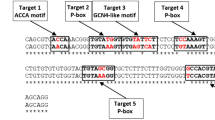Summary
The embryonic cell line, GV1, from Manduca sexta was transiently transfected with DNA constructs of the Drosophila hsp70 promoter fused to either a β-galactosidase (pXH70ZT) or a chloramphenicol acetyl transferase (HSP-CAT-1) reporter gene using lipofectin. Optimal cell density, DNA:lipofectin ratio, and time of incubation were varied to determine the optimal conditions: 2 × 105 cells/ml, 1:3, and 5 h. Under these conditions, the transfection efficiency was about 40%.
Heat inducibility of two hsp70 constructs was compared. The HSP-CAT-1, containing 1127 bp of upstream sequence, was more sensitive to heat shock than that of pXH70ZT, containing only 194 bp of upstream sequence. Thus, the 1127 bp hsp70 promoter appears to be a better inducible promoter in these cells. A 2 kb fragment of the proximal promoter region of the MHR3 gene containing a putative ecdysone response element was shown to be responsive to 20-hydroxyecdysone after its transfection into these cells.
Similar content being viewed by others
References
Amin, J.; Mestril, R.; Schiller, P., et al. Organization of the Drosophila melanogaster hsp70 heat shock regulation unit. Mol. Cell. Biol. 7:1055–1062; 1987.
Ausubel, F. M.; Brent, R.; Kingston, R. E., et al. Current protocols in molecular biology. Vol. 2. New York: John Wiley and Sons; 1995:10.185–10.186.
Cherbas, L.; Moss, R.; Cherbas, P. Transformation techniques for Drosophila cell lines. In: Goldstein, L. S. B.; Fyrberg, E. A., eds. Methods in cell biology. Vol. 44. New York: Academic Press; 1994:161–179.
Di Nocera, P. P.; Dawid, I. B. Transient expression of genes introduced into cultured cells of Drosophila. Proc. Natl. Acad. Sci. USA. 80:7095–7098; 1983.
Ehlert, F.; Bierbaum, P.; Schorr, J. Importance of DNA quality for transfection efficiency. BioTechniques 14:546–546; 1993.
Fallon, A. M. Factors affecting polybrene-mediated transfection of cultured Aedes albopictus (mosquito) cells. Exp. Cell Res. 166:535–542; 1986.
Fallon, A. M. Optimization of gene transfer in cultured insect cells. J. Tissue Cult. Meth. 12:1–6; 1989.
Felgner, P. I.; Gadek, T. R.; Holm, M., et al. Lipofection: a highly efficient, lipid-mediated DNA-transfection procedure. Proc. Natl. Acad. Sci. USA. 84:7413–7417; 1987.
Fittinghoff, C. M.; Riddiford, L. M. Heat sensitivity and protein synthesis during heat-shock in the tobacco hornworm, Manduca sexta. J. Comp. Physiol. B. 160:349–356; 1990.
Gerenday, A.; Park, Y.-J.; Lan, Q., et al. Expression of a heat-inducible gene in transfected mosquito cells. Insect Biochem. 19:678–686; 1989.
Harrison, G. S.; Wany, Y.; Tomczak, J., et al. Optimization of gene transfer using cationic lipids in cell lines and primary human CD4+ and CD34+ hematopoietic cells. BioTechniques 19:816–823; 1995.
Helgen, J. C.; Fallon, A. M. Polybrene-mediated transfection of cultured lepidopteran cells: induction of a Drosophila heat shock promoter. In Vitro Cell. Dev. Biol. 26:731–736; 1990.
Holmgren, R.; Livak, K.; Morimoto, R., et al. Studies of cloned sequences from four Drosophila heat shock loci. Cell 18:1359–1370; 1979.
Lan, Q.; Wu, Z.-L.; Riddiford, L. M. Regulation of the ecdysone receptor, USP, E75 and MHR3 mRNAs by 20-hydroxyecdysone in the GV1 cell line of the tobacco hornworm, Manduca sexta. Insect Mol. Biol.; in press: 1996.
Lindquist, S. Varying patterns of protein synthesis in Drosophila during heat shock: implications for regulation. Dev. Biol. 77:463–479; 1980.
Lu, M.; Johnson, R. R. Iatrou, K. Trans-activation of a cell house keeping gene promoter by the IE1 gene product of Baculoviruses. Virology 218:103–113; 1996.
Lycett, G. J.; Crampton, J. M. Stable transformation of mosquito cell lines using a hsp::neo fusion gene. Gene 136:129–136; 1993.
Lynn, D. E.; Oberlander, H. The effect of cytoskeletal disrupting agents on the morphological response of a cloned Manduca sexta cell line to 20-hydroxyecdysone. Wilhelm Roux’s Arch. 190:150–155; 1981.
Mirault, M.-E.; Southgate, R.; Delwart, E. Regulation of heat-shock genes: a DNA sequence upstream of Drosophila hsp70 genes is essential for their induction in monkey cells. EMBO J. 1:1279–1285; 1982.
Moran, L.; Mirault, M.-E.; Tissieres, A. Physical map of two D. melanogaster DNA segments containing sequences coding for the 70,000 dalton heat shock protein. Cell 17:1–8; 1979.
Palli, S. R.; Hiruma, K.; Riddiford, L. M. An ecdysteroid-inducible Manduca gene similar to the Drosophila DHR3 gene, a member of the steroid hormone receptor superfamily. Dev. Biol. 150:306–318; 1992.
Pelham, H. R. B.; Bienz, M. A synthetic heat-shock promoter element confers heat-inducibility on the herpes simplex virus thymidine kinase gene. EMBO J. 1:1473–1477; 1982.
Stiles, B.; Heilmann, J.; Sparks, R. B., et al. Transfection of cultured cells of cotton boll weevil, Anthonomus grandis, with a heat-shock-promoter-chloramphenicol-acetyl transferase construct. Insect Mol. Biol. 1:81–88; 1992.
Vulsteke, V.; Janssen, I.; Vanden Broeck, J., et al. Baculovirus immediate early gene promoter based expression vectors for transient and stable transformation of insect cells. Insect Mol. Biol. 2:195–204; 1993.
Weber, M.; Moller, K.; Welzeck, M., et al. Effects of lipopolysaccharide on transfection efficiency in eukaryotic cells. BioTechniques 19:930–940; 1996.
Author information
Authors and Affiliations
Rights and permissions
About this article
Cite this article
Lan, Q., Riddiford, L.M. DNA transfection in the ecdysteroid-responsive GV1 cell line from the tobacco hornworm, Manduca sexta . In Vitro Cell.Dev.Biol.-Animal 33, 615–621 (1997). https://doi.org/10.1007/s11626-997-0111-5
Received:
Accepted:
Issue Date:
DOI: https://doi.org/10.1007/s11626-997-0111-5




